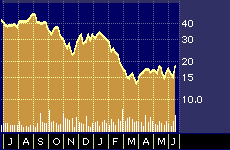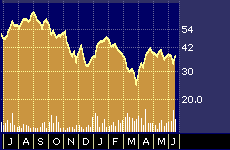
Oracle Under Pressure
Oracle Under Pressure
By Hal Plotkin
CNBC.com Silicon Valley Correspondent
Jun 22, 2001 09:05 AM

Oracle 52-week stock performance
Oracle Corp.’s {ORCL} stock moved up roughly 20 percent this week as investors reacted positively to suggestions from the company that its sales slump may be bottoming out. But even analysts who are positive on the stock are warning that Oracle faces some very tough comparisons over the next two quarters that could limit further near-term appreciation.
“We expect Oracle’s decidedly better tone about emerging business trends could provide a near-term boost to stocks within the software sector,” says Merrill Lynch first vice president Christopher Shilakes, in a research note published late Tuesday, just after Oracle announced its results for its fourth quarter, ended May 31.
“However, any concerted rally may be short lived, as the pending second quarter pre-announcement season could place pressure on the sector again,” Shilakes adds.
On Tuesday, Oracle reported earning $855 million, or 15 cents a share, compared with $926 million, or an adjusted 16 cents a share for the same period last year. Analysts had reduced their consensus estimate for the quarter to 14 cents a share in May, according to estimates compiled by First Call Corp., which helped Oracle beat the consensus analysis estimate by a penny per share.
CNBC.com: PeopleSoft Gaining on Oracle
Shilakes upgraded Oracle’s stock from accumulate to buy after Oracle’s earnings announcement based on the company’s long-term positioning. But he also warned that a big threat to Oracle’s stock right now comes from the company itself, more specifically, from the outstanding performance Oracle posted during the tail end of the Internet frenzy last year when many dot com and corporate customers alike were rushing toward Internet-based business models with little apparent regard to the costs involved.
“We are modestly raising our fiscal year 2002 earnings per share estimates, but remain concerned about the visibility into first half 2002 earnings, as prior year comparisons remain difficult through the second quarter [of] 2002,” notes Shilakes.
Industry analysts add that Oracle faces several significant marketing challenges, as well, over the next six months in the currently hard-pressed applications side of its business, the outcome of which remains uncertain. Oracle still generates healthy income from its core database business but has targeted Internet applications as its main future growth engine.
Over the most recent quarter, however, revenues from Oracle’s Internet applications business slid by nearly 25 percent to $338 million, despite widespread analyst projections of growth in that area. The slowdown is linked, in part, to increasingly strong competition from other vendors of Internet application suites such as PeopleSoft Inc. {PSFT}.
Another big and as yet unresolved issue is whether customers will be attracted to Oracle’s overall strategy of bundling Internet applications in a comprehensive soup-to-nuts suite or whether customers will be more attracted to other vendors, such as SAP AG {SAP}, that provide customers with the ability to link best-of-breed Internet applications from a number of different vendors.

SAP 52-week stock performance
“SAP seems to be taking on a more aggressive role in the marketplace and is positioning itself as the Oracle antagonist, which could be a good move to put SAP more in the spotlight,” according to Kelly Spang, an analyst at Current Analysis, based in Sterling, Virginia.
The research team at Current Analysis takes a generally positive stance on Oracle’s prospects moving forward. But they add that the company’s marketing strategy could prove problematic at exactly the moment when strong sales of applications are needed to revive growth.
“Oracle emphasizes the value of an e-business solution and discredits a mix-and-match integration approach with best-of-breed applications,” say Spang and her colleague, Jill Jenkins, in a recently published study of Oracle that was made available to clients of the high-tech market research and analysis firm.
“This message isn’t likely to go over well with Oracle’s own consulting operation and its third-party partners,” they add. “While this message justifies Oracle’s packaging of its e-business suite, this message could cause integrator partners to go out of their way to promote non-Oracle solutions.”
The problem for Oracle, note several analysts, is that customers could flock to best-of-breed solutions in certain areas of online commerce if and when one or more of those software packages provides a measurable impact on the bottom line of firms that often compete fiercely with one another in their own markets. It’s uncertain how many customers will stick with an all-inclusive suite of Internet applications if it becomes clear that decision is creating a competitive advantage for any of their rivals.
“As Oracle spreads its resources across so many applications, there is concern about whether it is able to maintain a competitive development schedule to add functionality across its e-business suite that rivals best-of-breed specialists,” notes the recent report from Current Analysis.
As such, some analysts think investors who bid up Oracle’s stock this week may have jumped the gun, particularly if the economy continues to worsen.
“Although Oracle seems to have moved past the worst, it faces tough comparables in the next two quarters,” confirms Dain Rauscher Wessels analysts Kash Rangan and Cameron Steele, in a post-earnings announcement report published this week.
The Dain Rauscher Wessels analysts nonetheless maintained their buy-aggressive rating on the stock, which implies risk, along with their $19 12-month price target.


